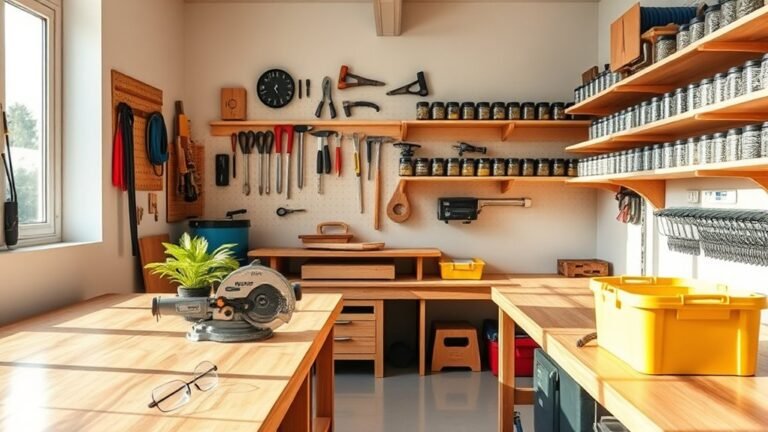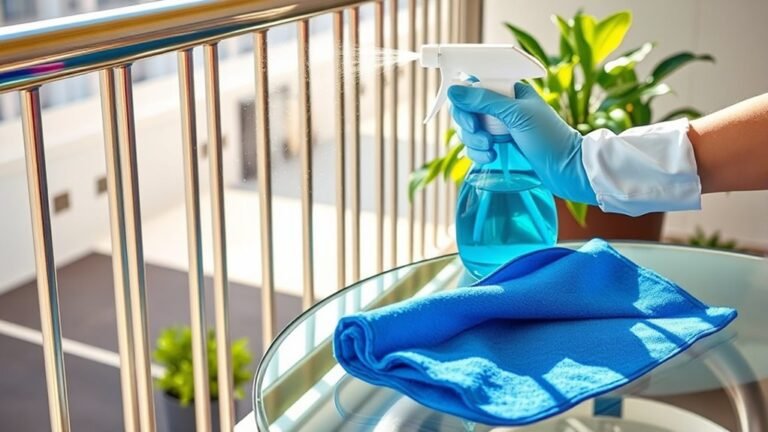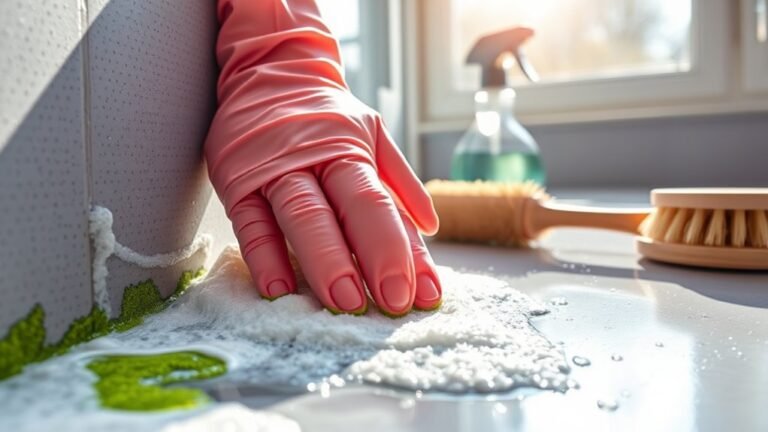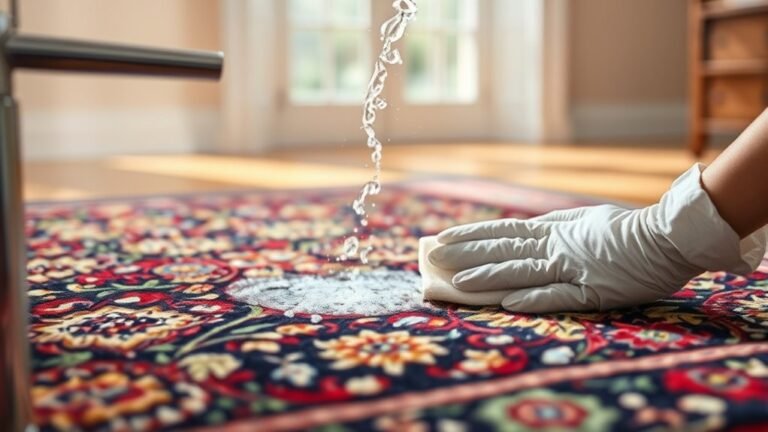How to Clean Attic Floors
Before you start cleaning attic floors, check for damage or weak spots to stay safe. Gather supplies like a vacuum with a HEPA filter, broom, gloves, and mask. Clear debris gently, avoiding insulation disturbance, and address any moisture or mold by improving ventilation and applying treatments. Regular cleaning prevents dust buildup and keeps your attic healthy. If you want to tackle pest issues or protect insulation, there’s more to explore for an efficient attic care routine.
Assessing the Condition of Your Attic Floors

Before you begin cleaning, you’ll want to carefully assess the condition of your attic floors. This attic floor inspection is essential because it helps you understand the space you’re working with and guarantees your safety. Check for any signs of damage, like cracks, soft spots, or sagging boards that could indicate compromised structural integrity. If the floor feels unstable, don’t risk walking on it without reinforcement or professional advice. Freedom in your home means being confident and secure, so taking the time to evaluate your attic floors lets you move forward with cleaning without worry. By knowing exactly what you’re dealing with, you can plan your approach effectively and keep your attic a safe, clean space.
Gathering the Necessary Cleaning Supplies
Before you start cleaning, make sure you have the right tools like a broom, vacuum, and dustpan. Don’t forget to wear protective gear such as gloves and a mask to keep yourself safe. Also, choose cleaning solutions that are effective but safe for your attic’s materials.
Essential Cleaning Tools
A sturdy broom and a reliable vacuum are your best friends when tackling attic floors. Choosing the right cleaning equipment depends on the floor materials you’re dealing with—whether it’s wood, plywood, or insulation panels. To keep your attic clean and free, make sure you have:
- A broom with stiff bristles to sweep away dust and debris without damaging delicate floor materials.
- A vacuum cleaner with strong suction and a long hose to reach tight corners and remove fine particles.
- A dustpan and brush combo for quick collection of swept-up dirt, making the task smoother and faster.
These essential tools give you the freedom to clean efficiently, maintaining your attic’s condition while respecting the unique surface beneath your feet.
Protective Gear Importance
Two essential pieces of protective gear you can’t skip when cleaning attic floors are gloves and a dust mask. These safety precautions protect you from harmful dust, insulation fibers, and potential mold spores lurking in the attic. Wearing gloves shields your hands from sharp debris and irritants, while a dust mask keeps your lungs safe, letting you breathe freely without worry. Along with these, consider safety goggles and long sleeves as part of your protective equipment to guard your eyes and skin. Taking these simple steps guarantees you maintain your freedom to work confidently and safely. Don’t underestimate the importance of preparing yourself well—it’s the key to a smooth, hazard-free cleaning experience in your attic space.
Choosing Cleaning Solutions
Selecting the right cleaning solutions is essential to effectively tackle dust, dirt, and debris on your attic floors without causing damage. You want products that free you from harsh chemicals yet still get the job done thoroughly. Consider these options before you start:
- Natural cleaners – These are great if you prefer eco-friendly choices that won’t leave toxic residues or irritate your skin and lungs. Vinegar and baking soda blends work well.
- Chemical cleaners – Use these only if stubborn stains persist. Make sure they’re safe for wood or the specific material your attic floor has.
- Multipurpose sprays – Versatile and convenient, these can save time but check ingredients to avoid harsh substances.
Picking the right solution lets you clean with confidence and keeps your attic a safe, fresh space.
Preparing the Attic for Cleaning
Before you start cleaning, make certain the attic is safe and accessible by checking for exposed nails, loose boards, or insulation that could irritate your skin. Taking these safety precautions guarantees you won’t get hurt while working in this often cramped space. Next, focus on attic organization—clear pathways to move freely and group stored items so you can easily reach the floors. Wear protective gear like gloves, a mask, and sturdy shoes to guard against dust and debris. Also, make sure the attic is well-ventilated to keep fresh air flowing as you work. By prepping the space thoughtfully, you’ll maintain your freedom to move and clean efficiently without unnecessary risks or obstacles standing in your way.
Removing Debris and Dust From the Floors

Start by picking up any large debris scattered across the attic floor to make the space easier to clean. Next, use a broom or vacuum with a HEPA filter to remove dust effectively without spreading it around. Taking these steps will help you create a cleaner, safer environment in your attic.
Clearing Large Debris
Dealing with large debris is the first step in clearing your attic floors effectively. You’ll want to identify various debris types first—like broken wood, insulation chunks, or old boxes. Knowing what you’re handling helps you choose the right disposal methods and keeps the process smooth.
Here’s how to tackle it:
- Sort debris by material—wood, metal, or general trash—to streamline disposal.
- Use gloves and a sturdy bag or container to collect items safely without risking injury.
- Dispose of debris according to local regulations, recycling when possible to stay eco-friendly.
Dust Removal Techniques
Once you’ve cleared large debris, you’ll want to focus on removing dust and smaller particles from your attic floors. Start by choosing vacuum techniques that prioritize dust containment to keep the air clean and prevent irritation. Use a vacuum with a HEPA filter if possible, as it traps fine dust effectively. Move systematically, covering every corner to free your space from hidden dust layers. Wearing a mask can boost your freedom to breathe easy while working. If a vacuum isn’t an option, gently sweep with a soft broom, but be mindful that dust will spread more easily without proper containment. Staying consistent with these dust removal techniques guarantees your attic remains a cleaner, healthier environment—letting you enjoy the freedom of a well-maintained space.
Handling Mold and Mildew in the Attic
Although mold and mildew thrive in damp, dark environments like attics, you can take effective steps to manage and remove them safely. Tackling mold prevention and mildew treatment will help you maintain a clean, healthy space.
- Improve ventilation: Open vents or install fans to reduce moisture buildup, cutting off mold’s favorite breeding ground.
- Use mold-killing solutions: Apply a mixture of water and vinegar or a commercial mildew treatment to affected areas, scrubbing gently to avoid damaging surfaces.
- Dry the area thoroughly: After cleaning, verify the attic is completely dry to prevent mold from returning.
Dealing With Pest Infestations

If pests have found their way into your attic, you’ll want to act quickly to prevent damage and health risks. Recognizing infestation signs early is key to effective pest prevention. Look for droppings, gnaw marks, or nesting materials as clear indicators. Once identified, sealing entry points and maintaining cleanliness can keep these intruders out.
| Infestation Signs | Pest Prevention Tips |
|---|---|
| Droppings | Seal cracks and gaps |
| Gnaw marks | Store food securely |
| Nests and debris | Use traps or repellents |
| Strange noises | Regular attic inspections |
| Unpleasant odors | Keep attic dry and ventilated |
Addressing infestations swiftly lets you reclaim your attic as a safe, clean space—freedom from pests included.
Protecting Insulation During Cleaning
After handling any pest issues in your attic, you’ll want to make certain your insulation stays intact during cleaning. Proper insulation protection not only preserves energy efficiency but also prevents costly repairs. To keep your attic insulation safe, focus on these key steps:
- Gentle Cleaning Techniques: Avoid heavy foot traffic and use tools that don’t disturb insulation fibers.
- Moisture Control: Make certain the area stays dry to prevent mold and mildew growth that can compromise insulation.
- Physical Barriers: Lay down protective boards or sheets before starting to clean, reducing direct contact with the insulation.
Maintaining Clean Attic Floors Regularly
Keeping your attic floors clean on a regular basis helps prevent the buildup of dust, debris, and potential allergens that could affect your home’s air quality. To enjoy this freedom from dirt and allergens, establish a cleaning schedule that suits your lifestyle—whether that’s quarterly or biannually. Regular maintenance doesn’t have to be a chore; just set reminders and stick to them. Use a vacuum with a HEPA filter or a broom to swiftly remove dust without disturbing insulation. Keep an eye out for signs of pests or moisture during each visit, addressing issues early to avoid bigger problems. By committing to regular maintenance, you’ll guarantee your attic remains a clean, safe space, giving you peace of mind and freeing you from unexpected repairs down the line.
Frequently Asked Questions
Can I Use a Vacuum Cleaner on All Types of Attic Flooring?
Imagine your attic floor is like a delicate dance floor—one misstep and the scene’s ruined. You can use a vacuum cleaner, but it depends on vacuum types and flooring materials. For sturdy plywood, a regular vacuum works fine, but for fragile insulation or loose boards, a soft brush attachment or handheld vacuum’s safer. You want freedom to clean without damage, so choose your tool wisely and glide over your attic floor like you own the dance.
How Often Should I Schedule Professional Attic Inspections?
You should schedule attic inspections at least once a year to keep your space safe and efficient. The attic inspection frequency can vary if you notice leaks or pests, so don’t hesitate to call a pro sooner. Professional cleaning benefits include spotting issues early, improving insulation, and preventing costly repairs. Staying on top of these inspections gives you the freedom to relax, knowing your home’s in good shape.
What Are the Best Lighting Options for Attic Cleaning?
For fantastic, functional lighting, you’ll want to favor LED lighting and natural illumination. LED lights deliver bright, energy-efficient beams that banish shadows, making your attic adventure easier and safer. Whenever possible, maximize natural illumination by opening windows or vents to welcome daylight. This freedom-friendly combo lets you see clearly without feeling confined. So, choose smart, sustainable sources that let you work with ease and embrace the open, airy attic atmosphere.
Are There Any Safety Concerns With Attic Floor Joists?
You should definitely watch out for joist stability when moving around your attic—stepping between joists can be risky since the ceiling below might not support your weight. Also, you don’t want to damage insulation integrity by crushing or displacing it, as that compromises energy efficiency. To keep your freedom to explore safe, always step directly on the joists and consider adding plywood boards for a stable walkway.
Can Attic Floor Cleaning Improve Home Energy Efficiency?
Did you know that up to 25% of your home’s energy can be lost through an unmaintained attic? By cleaning your attic floors, you’re not just tidying up—you’re boosting energy savings. Removing debris allows you to spot damaged insulation and keep it in good shape, which helps your home stay comfortable and your bills lower. Taking control of your attic means enjoying greater freedom from high energy costs.






